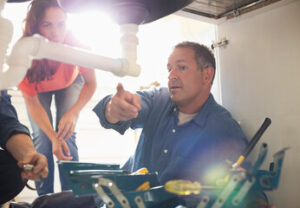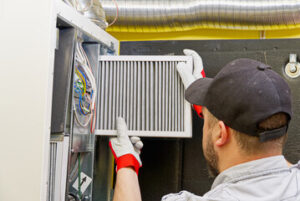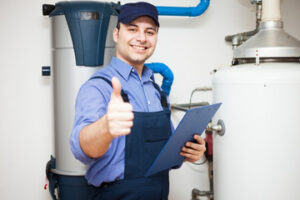Plumbers Sarasota install and maintain systems that provide water, hot-water production, sewage, and drainage in residential and commercial buildings. They also work with gas lines and appliances.

Plumbers often work on a contract basis and must travel between jobs. Their duties include interpreting blueprints and plans, inspecting existing pipework, testing pressure levels, fitting replacement parts, and installing fixtures such as sinks, toilets, and faucets.
Trees can add beauty to a yard, but their roots can invade your home’s plumbing and cause costly repairs. Tree roots seek out water and nutrients, and they can enter your sewer line and clog drains and toilets.
Backed up sewage can destroy your property’s foundation, frame, flooring and more. Plumbers can inspect your pipes for root damage and repair them as needed.
Plumbers can use several techniques to clear out your sewer lines of tree roots. One popular method is called hydro jetting, which involves inserting a pipe that emits a stream of high-pressure water. This effectively blasts the offending roots away from the pipe. Plumbers also may use chemical solutions such as potassium hydroxide or copper sulfate to stop the growth of roots in your pipes.
You can help prevent root problems by maintaining your yard and not letting grass grow too close to your sewer line. It’s a good idea to plant trees a reasonable distance away from your sewer line, too. Before you plant a new tree in your yard, ask your local plumber to check the location of your sewer line.
Slow-flowing drains and gurgling noises from your toilets are signs that root debris has clogged your drain line. Roots can also damage septic tanks and leach fields.
Your home’s sewer system is more than just a collection of pipes; it’s an intricate network that keeps your plumbing functioning properly. The plumbing experts can handle all of your installation, maintenance and repair needs — including unclogging drains. Contact us today to schedule an appointment! We’ll send a licensed technician to your home to diagnose any issues and provide you with a fair, upfront quote. Our mission is to keep your plumbing running smoothly! Our plumbers are all insured, bonded and licensed, so you can feel confident that the job will be done right the first time. Plus, we offer emergency services so you can get help when you need it. Don’t let a plumbing problem go untreated; call the pros at Mr. Plumber today!
Clogs
A major plumbing problem like a clogged sewer line is every homeowner’s worst nightmare. These problems can be expensive and time-consuming to fix. The best way to avoid costly clogs is by recognizing the warning signs and calling your local plumber as soon as possible.
Slow-Draining Water
If your sinks, bathtubs, or showers are draining slower than usual, it’s likely a sign of a bigger issue. Slow-moving water is often caused by hair, soap scum, and grease building up in the pipes. Eventually, these build-ups will stop the flow of water completely.
Foul-Smelling Drains
A foul odor coming from your drain is another surefire sign that you have a serious plumbing problem. If the smell is especially strong, it’s usually a sign of a clogged sewer line. In this case, it’s important to call a plumber right away because the smell will only get worse over time.
The Sounds of Strange Pipe Noises
Loud gurgling or bubbling sounds from your drains are another indication of a serious issue. These sound like air bubbles escaping from your pipes, and they may be a result of a clog. These noises could also mean that the pipe itself is broken or cracked.
The appearance of unexplained puddles around your home is another good indicator that you have a serious clog in the sewer line. This back-up of wastewater can be dangerous for your family, and it’s essential to contact a professional immediately. Plumbers can use state-of-the-art tools such as power-rodding or hydro-jetting to open blocked lines without damaging the pipes.
Lastly, keep in mind that many common bathroom toilet clogs can be avoided. For example, dental floss and “flushable” wipes should never be poured down the toilet, and you should always remove hair from the sink before washing.
Most clogs are the result of poor maintenance or usage, and can be easily prevented with the help of your local plumber. Don’t use chemical-based drain cleaners — they can damage your pipes. Likewise, be sure to ask bluefrog plumbing + drain about regular maintenance services that can prevent future issues.
Vehicle Damage
Plumbers are responsible for assembling, detecting issues, and repairing pipes that facilitate water and gas distribution in homes or establishments. Their job also involves fitting and servicing appliances like water heaters, dishwashers, and toilets. Plumbers use a variety of hand tools and powered tools to perform their duties. They often work in cramped spaces and must wear protective equipment. They may be exposed to hazardous materials, including lead, asbestos, silica, and solvents. They must read and interpret blueprints and drawings, and ensure their work complies with building codes.
Because they are on-call, plumbers must be able to respond quickly to emergency calls. This requires excellent critical thinking skills to evaluate the nature of the problem and find effective solutions. Communication skills are also necessary to relay instructions to other workers and clients. Plumbers must be able to explain the costs and timeframe of repairs, and build rapport with customers.
The path to becoming a plumber starts with earning a high school diploma or equivalent. Then, plumbers enter an apprenticeship program that combines classroom learning with on-the-job training. Apprentices earn hourly wages and work under the supervision of a certified plumber, called a journeyperson. They typically need to complete an apprenticeship for four to five years to become fully qualified.
After completion of an apprenticeship, plumbers must pass a state exam to obtain their license. The licensing requirements vary by state, but all require passing a test that covers plumbing codes and regulations. Additionally, some plumbers choose to pursue additional certifications to show their competency in particular areas of plumbing. For example, some plumbers become certified in green plumbing practices or working with specific types of equipment.
Sewage Backups
Sewage backups are a nightmare for any homeowner because of the severe damage they can cause and the health risks they pose. While you may be able to handle small sewage backups by flushing toilets and using a wet/dry vacuum, the best course of action is to call a professional plumber as soon as possible.
If you notice a foul smell in your home or sewage backing up out of your drains, it’s a clear sign that your main sewer line has backed up and you need emergency plumbing services. Raw sewage contains human waste, minerals and garbage, which can contaminate your water supply and lead to serious illness for you and your family members. It’s also a health risk for pets and other animals who come into contact with it.
The main sewer line is usually located outside or in the lowest part of your house, such as the basement or garage. This line is where all wastewater in your home flows to the septic tank or public city connection. The main sewer line is only large enough for human waste and toilet paper to wash through, so it’s easy for items that are not meant to go down the drain to clog or block the line.
Tree roots, shrub twigs, and other natural growths often enter old clay pipes and slowly clog them over time. When a clog occurs, it’s only a matter of time before the black water from your home begins to back up.
When the sewage isn’t stopped, it can seep through walls and floors and ruin furniture, flooring, carpets, and other household items. It can also cause mold and other health issues for your family members.
The first step in handling a sewage problem is to shut off the main water valve and avoid using any appliances until the problem has been fixed. It’s also important to wear protective clothing, such as a face mask, eye protection, and rubber gloves. You should also evacuate the area and open windows and doors to ventilate it.
Homeowners should also check with their insurance company to find out whether or not sewage backups are covered under their policy. Regular inspections of your home’s sewer line and early repair of any damage can help prevent sewage backups in the future.

